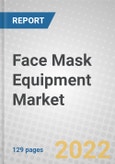Report Scope:
This report covers the technological, economic and business considerations of the face mask market, with analyses and forecasts provided for global markets. It includes relevant descriptions of market forces and their areas of application.
Global markets are presented by face mask type, along with growth forecasts through 2027. Estimates on sales value are based on the price in the supply chain at which the face masks are procured by the manufacturers.
Market-driving forces and industry structure are examined. International aspects are analyzed for all regions and face masks technologies. Brief profiles of major global manufacturers are presented.The COVID-19 pandemic recently halted global economic progress. Lockdown measures were taken to contain the spread of the coronavirus, especially in affected cities, and various international governments took the necessary measures to address the economic slowdown.
In 2020, the growth rate of every global industry was impacted by the pandemic, and in turn the face mask market was affected. The market is expected to bounce back in 2022 due to relief packages or disaster aid packages provided by various governments to boost their economies.
Report Includes
- 210 data tables 23 additional tables
- An overview of the global market for face masks equipment
- Estimation of the market size and analyses of global market trends, with data from 2021, estimates for 2022, 2023 with projections of compound annual growth rates (CAGRs) through 2027
- Analysis of the current market trends, market forecast, opportunities and economic trends that are affecting the future marketplace
- Highlights of the current market scenario, recent information, latest developments, and factors impacting the growth of the market
- Description of different types of masks including surgical mask and N-series mask (N 95, N 99, etc.) and discussion on awareness of face masks usage due to coronavirus impact
- Identification of market drivers, restraints and other forces impacting the global market and evaluation of current market size and forecast, and assessment of new developments in the industry
- Market share analysis of the key companies of the industry and coverage of their proprietary technologies, strategic alliances, and other key market strategies and a relevant patent analysis
- Comprehensive company profiles of the leading players, including 3M, Cardinal Health, Honeywell International and UVEX Group
Table of Contents
Executive Summary
Face masks are pieces of personal protective equipment that serve to protect against airborne diseases, such as COVID19, influenza, chickenpox, mumps and measles. The nose, chin and mouth are all protected by this half-face mask. The demand for face masks among frontline health professionals (e.g., first responders, nurses, medical practitioners) is fueled by the development of respiratory infectionbased pandemic illnesses, such as H1N1 and COVID-19. N95 respirator masks are becoming increasingly popular for protecting healthcare personnel from dangerous viruses and microorganisms. At the beginning of the pandemic, health regulators suggested that the use of N95 respirators be confined to
healthcare personnel, but as supplies increased, a growing number of people purchased these masks to reduce the chance of contracting COVID-19 and stopping its global spread.
Pandemic diseases such as COVID-19 and H1N1, and other infectious viruses have claimed millions of lives. Social isolation and the use of face masks are the only ways to protect people from contagious viruses. Governments increased production activities to avoid face mask shortages, which has fueled the expansion of the face mask market. The U.S. government directed Honeywell International to increase the manufacture of N95 masks in the country so that masks would be available to the general public. The face mask market is generally segmented into five primary segments: material, mask type, usage, distribution channel and applications.
The global face mask material market is segmented into cotton, polypropylene and others (e.g., polyurethane, polyester, PET, rubber). In 2021, the polypropylene non-woven fabric segment dominated the market. Polypropylene, one of the major commodity plastic resins, is produced in large quantities in many countries. It can be easily converted into spun-bonded fabric and structured with a wide range of properties, so it is considered a major raw material for face mask production.
The global face mask by type market is segmented into surgical, N-series, respirators and others (e.g., dust resistant, procedural masks, fashion masks). In 2021, the surgical masks segment was dominant. These masks are mainly used in healthcare application, but due to the rise in COVID-19 cases, many residential households started using them, leading to an increase in their market share.
The global face mask market by usage is segmented into disposable and reusable. In 2021, the reusable mask segment was dominant. Shortages of disposable face masks, affordability and ease of use resulted in massive adoption of reusable face masks.
The global face mask market by distribution channel is segmented into online and offline. In 2021, the online sales segment was dominant. In the offline segment, major sales shares were contributed by retailers and convenience stores.
The global face mask market by application is segmented into healthcare, personal and industrial. In 2021, the healthcare sector dominated the application market, as it includes the primary users of respirators and surgical masks to prevent the inhalation of bacteria and viruses. Mandatory use of face masks in hospitals and clinics became part of the infection control strategy and helped to reduce cross contamination between patients and nursing staff.
Companies Mentioned
- 3M
- Alpha Pro Tech Inc.
- Cardinal Health
- Gerson Co.
- Honeywell International
- Kimberly-Clark
- Kowa Co. Ltd.
- Moldex-Metric Inc.
- Owens & Minor
- Uvex Group








